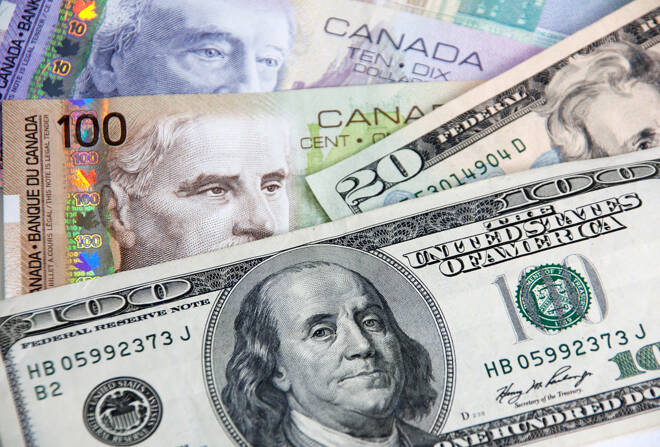Advertisement
Advertisement
USD/CAD: Loonie Set to Post Worst Weekly Fall in 17 Months
By:
The Canadian dollar is set to post its worst weekly loss against its U.S. counterpart on Friday as currency traders moved to the safety of the greenback amid rising concerns that global economic activity is slowing.
The Canadian dollar is set to post its worst weekly loss against its U.S. counterpart on Friday as currency traders moved to the safety of the greenback amid rising concerns that global economic activity is slowing.
The USD/CAD hit an eight-month high of 1.2948 today, up from Thursday’s close of 1.2826. The Canadian dollar lost about 1% in July – the second biggest monthly decline since September 2020 – and has further dropped about 3% this month.
“Risk-off mood on delta variant anxiety hits CAD. USDCAD rose to the mid-1.29 area (a year-to-date high) after quickly taking out four-figure marks this week as market angst builds over the spread of the delta variant globally and the threat to economic growth and commodities demand. WTI crude oil lost 8% since last Friday while iron ore dropped by over a fifth as Chinese steel production looks to slow considerably in the months ahead amid reduced demand and production curbs to tackle pollution,” noted Shaun Osborne, Chief FX Strategist at Scotiabank.
“Technically, the USDCAD is in overbought territory with the signal acting as a trigger for corrections in the USD in June and July. The 1.30 zone will also act as strong resistance as it roughly marked the bottom in USDCAD through 2019 and the latter part of 2020; the 38.2% Fib retracement of the Mar 2020-Jun 2021 decline at 1.3024 follows as resistance. Support markers are limited aside from psychological floors at the big figure zones with the 1.28 area standing as the firmest floor to prevent declines until the next key support at 1.26.”
The dollar index, which measures the value of the dollar against six foreign currencies, was trading 0.04% higher at 93.60, hitting a nine-month high as Fed is on track to taper this year.
According to the Fed minutes released on Wednesday, if the economy continues to improve as expected, the Fed may reduce the bond-buying stimulus this year. That means the Fed will not flood the financial system with cash if they reduce debt purchases. This is typically positive for the U.S. dollar.
The greenback was also supported by hawkish remarks from the US Federal Reserve makers in the past which led markets to move forward with expectations of policy tightening. The Federal Reserve may move forward on tapering asset purchases and increase rates sooner if the inflation rate rises. This could effectively push the dollar up in value.
It is likely that the world’s dominant reserve currency, the USD, will rise over the coming year, largely due to the expectation of two rate hikes by the Fed in 2023. With the dollar strengthening and a possibility that the Federal Reserve will raise interest rates earlier than expected, the USD/CAD pair may experience a rise.
Canada is the world’s fourth-largest exporter of oil, which edged lower on a strong dollar. U.S. West Texas Intermediate (WTI) crude futures were trading 0.60% lower at $63.31 a barrel. Lower oil prices lead to lower U.S. dollar earnings for Canadian exporters, resulting in a decreased value of the loonie.
The slowing Chinese economy dampened sentiment. An economic slowdown in China sent global shares down for a fifth consecutive day. Meanwhile, the spread of the Delta COVID-19 variant knocked investors off balance. As a major exporter of commodities, including oil, Canada’s dollar tends to be sensitive to the outlook for global economic growth.
About the Author
Vivek Kumarauthor
Vivek has over five years of experience in working for the financial market as a strategist and economist.
Did you find this article useful?
Latest news and analysis
Advertisement
